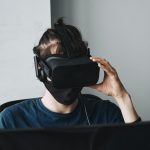PwC estimated $1.5 trillion will be contributed by AR/VR to the global economy by 2030. Whilst this is a pretty mind blowing estimation, I cannot help but think, what does this mean for the Australian business market, where currently there hasn’t been a huge uptake of virtual reality for employee training purposes?
Through research, I found a recent report by Samsung Electronics Australia which pointed out how Australian businesses are interested in investing in VR technology. The report stated that VR made it in Australia’s top 5 list of emerging technologies, and as a result, will be one of the most popular choices of technology that businesses will be investing in, in the future.
The report included data taken from a quantitative survey filled out by 387 Australian Firms. It consisted of a number of questions about ‘reality technologies’, a term used to refer to the up and coming technologies of: Virtual Reality, Augmented Reality and Mixed Reality. Of the study’s findings, what stood out most to me was how clear it is that Australian companies are viewing “Reality Technologies” with opportunistic eyes:
“Within the next two years, in total 49% of companies expect to develop some form of virtual reality solution, 47% expect to develop an augmented reality solution and 43% a mixed reality solution.”
This equates to almost one in ten Australian companies that are showing serious interest in what reality technology can do to support business initiatives. In fact, many of these firms claimed to already have developed a proof of concept (POC), and have even put aside a budget that will one day be used to carry out reality technology solutions.
What type of businesses can benefit from using VR?
Interestingly, the deployment of Virtual Reality was most strongly favoured by Government and Education industries that participated in the survey. However, other industries that also showed significant interest in VR technology were Health and Retail. According to a report by Deloitte’s, analysts have predicted the retail industry will experience the highest beneficiaries in adopting VR/AR technologies down the line.
At present, one thing is apparent- that is VR’s flexibility to cater to each of these industries in entirely different ways. For example, it was revealed that schools are choosing to use VR for multi-user excursions, whilst retail stores are adopting VR as part of sales promotions. In terms of employee training, it was highlighted that logistic and manufacturing sectors were using VR to train and educate employees in the areas of OHS and mandatory compliance. According to Samsung’s study, VR ranked the highest against AR and MR when it comes to training and education. Coupled with that, companies that already deployed a reality technology solution, noticed an improvement in education, leading to cost reductions of 2.8%.
Another common factor, that these businesses shared, was that each is seeking a reality technology solution to help improve three key business areas. These include: competitive differentiation, customer engagement and digital transformation initiatives. So, there really are no limitations for large companies wanting to contact an agency to create a VR training solution (aside from setting aside high budgets for the cost of production and maintenance).
It’s time to comply with new technology
Many people don’t know about the rich history of VR, but VR headsets have been around since the 60’s! (To read more on the history of VR, click here!) Now is the most exciting time for VR as the shift has been made to the business world and it is growing increasingly successful as a business training and development tool.
VR blurs the line between digital worlds and real life environments, making it a sought-after alternative for training employees in achieving learning outcomes that weren’t always available. A business can rebrand itself as innovative and agile as through the process of adopting better performance methods and supported data-driven decision making, VR can conceptualise information to make it highly engaging and a lot easier to understand. It also is being used to open up new prospects for improving the customer experience like at IKEA. Customers looking to design a new kitchen, can try out possible layouts and furniture, via an app and VR headset. No longer do we need to waste time over our decisions because the power of VR enables our visualisations to come alive in 3D.
So it only makes sense that Australian businesses look at VR as a forward-thinking solution that can become a driver for competency and efficiency. Regulatory compliance training and delivery of the outdated laborious ways of the past, need to leap into the future. It is time to revamp and upgrade. Australia, it’s time to jump on board and embrace the game changing immersive experience that is VR. To join the VR journey, make sure to check out our website and find out how VR can work for you.
Written by Lauren Tizzone
Similar articles to check out:







